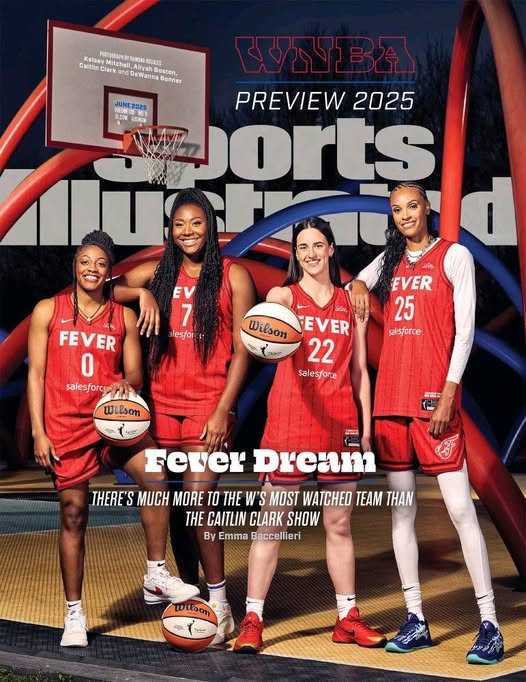The Indiana Fever have long been a team defined by patience and rebuilding, often flying under the radar in a league dominated by headline-grabbing superstars and powerhouse franchises. But this offseason, the narrative around the Fever has dramatically shifted. There’s much more to Indiana than just the buzz around Caitlin Clark, the electrifying star who has captivated basketball fans with her dazzling playmaking and scoring prowess. While Clark’s arrival undeniably elevates the team’s profile, Indiana’s transformation runs far deeper than any single player’s spotlight. This offseason marked a decisive pivot from a steady rebuild toward a full-fledged push to win now, driven by sweeping upgrades to the organization’s front office, coaching staff, bench depth, and overall roster construction.
For years, the Fever have been quietly cultivating talent, piecing together young prospects, and slowly building a foundation for the future. However, patience only goes so far in a league as competitive and fast-paced as the WNBA. The gap between playoff hopefuls and championship contenders often comes down to strategic personnel decisions and how quickly a team can transition from developing players to assembling a balanced, versatile roster capable of executing under pressure. Indiana’s recent moves reflect a franchise unwilling to settle for mediocrity or prolonged rebuilding timelines. Instead, they are seizing the moment, capitalizing on the momentum Caitlin Clark’s presence brings, and surrounding her with the kind of support and leadership necessary to contend immediately.
At the heart of Indiana’s offseason overhaul was a significant restructuring of their front office. Recognizing that championship-caliber teams are built from the ground up with strong, visionary leadership, the Fever brought in experienced executives with a track record of success. This was no minor tweak; the front office makeover signaled a commitment to a new culture focused on winning, accountability, and innovation. Veteran basketball minds with deep understanding of player development, analytics, and scouting have been tasked with crafting a roster that blends youth with experience, athleticism with savvy, and grit with skill. This infusion of expertise at the management level means that Indiana’s roster decisions, from draft picks to trades and free agent signings, are grounded in a clear strategic plan rather than reactive or short-term thinking.
Coaching was another major area of improvement. The Fever upgraded their coaching staff with a focus on bringing in leaders who emphasize both tactical discipline and player empowerment. Coaching in the WNBA is about more than just drawing up plays; it’s about cultivating chemistry, adapting to fast-changing game situations, and developing individual players into integral pieces of a collective unit. Indiana’s new coaching hires have demonstrated an ability to elevate team defense, optimize offensive schemes around dynamic guards like Clark, and maximize bench contributions. The team’s coaching philosophy now centers on aggressive, high-energy play combined with the flexibility to switch gears when necessary, whether it’s pushing the pace in transition or grinding out close games in the half court.
Beyond leadership and coaching, Indiana’s bench saw considerable upgrades that add depth and versatility to the lineup. One of the most glaring challenges for the Fever in previous seasons was a lack of reliable, productive reserves who could maintain intensity and quality when starters rested. This offseason, Indiana signed several key veterans and promising young players to bolster their second unit. These bench additions provide a valuable combination of scoring punch, defensive tenacity, and floor spacing that can change the complexion of games when the starters are off the court. In a league where every possession matters and rotations can swing momentum, having a bench that can consistently contribute is a competitive edge that Indiana now possesses.
Importantly, the Fever’s offseason moves reflect a broader, more balanced roster construction philosophy rather than a singular focus on Clark’s offensive talents. While she will undoubtedly be the focal point on offense, the team has built complementary pieces that can create matchup problems for opponents. Indiana’s new roster additions bring a mix of perimeter shooting, interior presence, and defensive versatility. This means defenses cannot simply key on Clark without risking exploitation elsewhere. The Fever can spread the floor with sharpshooters, apply pressure with aggressive defenders, and establish a physical presence inside the paint. This diversified approach is crucial because relying too heavily on one player leaves a team vulnerable in the playoffs, where adjustments and tight defenses are the norm.
Moreover, the Fever’s front office showed a clear understanding of the importance of chemistry and intangibles in winning basketball. The players they targeted are not just skilled athletes but individuals known for their professionalism, work ethic, and team-first mentality. Building a winning culture often requires finding players who buy into the collective vision and are willing to play roles that might not always fill highlight reels but contribute to victory. Indiana’s offseason roster additions fit this mold, suggesting a deliberate effort to craft a cohesive unit where egos are managed, roles are clear, and everyone pulls in the same direction.
Another factor that sets this iteration of the Fever apart is their increased financial flexibility and willingness to invest in talent. The WNBA’s evolving salary structure and collective bargaining agreements have made it easier for teams to maneuver in free agency and build more competitive rosters. Indiana took advantage of this by making smart, targeted acquisitions that not only improve the team immediately but also create a foundation for sustained success. This willingness to spend and allocate resources strategically reflects a shift in organizational ambition and confidence.
The Fever’s fans should also take note of the organization’s renewed emphasis on marketing and community engagement. The presence of a transcendent player like Caitlin Clark naturally draws attention, but the franchise is working hard to capitalize on this by enhancing fan experiences, expanding outreach efforts, and building a stronger brand identity. Creating a passionate home-court atmosphere is another key ingredient in winning basketball, and Indiana’s front office seems determined to cultivate that energy. This holistic approach, blending on-court upgrades with off-court initiatives, is what transforms a team from an also-ran to a contender in both basketball and fan engagement.
As the 2025 WNBA season approaches, Indiana’s Fever look more like a team with a championship mindset rather than a long-term project. The combination of top-tier talent, improved leadership, coaching upgrades, and a deep, versatile bench sets the stage for them to compete at a high level from the opening tip. While Caitlin Clark remains the headline, the Fever’s success will hinge on how well the entire roster meshes, how effectively the coaching staff implements their vision, and how resilient the team is under playoff pressure. But with the comprehensive upgrades made this offseason, Indiana has taken giant strides toward transforming from a rebuilding franchise into a legitimate title contender.
In a league where parity is increasing and surprises are common, Indiana’s Fever are no longer content to be on the outside looking in. Their aggressive moves signal a clear intent to win now. The steady rebuild is behind them. The new Fever are a team ready to seize the moment, leveraging both star power and organizational excellence to challenge the best in the WNBA. For fans, players, and the wider basketball community, Indiana’s transformation this offseason is a thrilling story of ambition, strategy, and the unrelenting pursuit of victory. The Fever are no longer just about Caitlin Clark’s show — they’re about a complete team ready to make noise and win.



